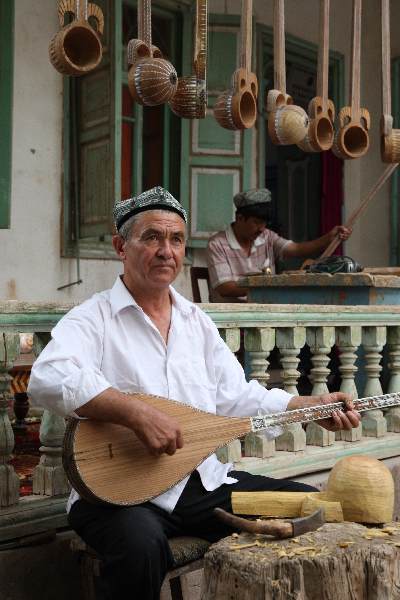
Rahman Abdulla plays a musical instrument produced by his workshop (ZOU YI)
Tea houses are encountered here and there across the old town, where locals can be seen eating naans, tasting teas and chatting with one another, all longstanding traditions for the Uygur people. A two-story tea house in the downtown area is the only one in Kashgar with a history dating back over 100 years. The outer wall of the establishment is painted green, with Uygur-style decorations adorning its door and windows. Inside the building, about a dozen elderly Uygur men sit leisurely on carpets drinking tea and talking slowly in hushed tones. The yellow-and-green curtains on the balcony of the second floor flutter in the wind, adding a strong ethnic atmosphere to the building. Because of its quintessentially Muslim nature, the tea house was selected as one of the shooting locations for the 2007 Hollywood film The Kite Runner.
The tea served in the tea house is relatively inexpensive—the lowest price being 1.5 yuan ($0.24) for one pot, which is more than affordable for local residents. "I maintain this business mainly to provide local people with a place to meet and communicate with each other, and money is not the major consideration," said Mamat Osman, owner of the tea house.
Ablat, 70, a retired public servant, is a regular of the establishment. "I come here every day, and these days because of the summer heat, I might even come twice a day," he said. Ablat enjoys meeting and chatting with his old friends here and considers it a good way to spend his retirement.
From the tea house, visitor can view Id Kah Mosque, a grand structure lying not too far away. The mosque is the most important in Xinjiang and is also the largest one in China. Nearly 3,000 Muslims pray here every day, and on Friday the number of worshippers may exceed 5,000. During Eid al-Adha, one of the important festivals on the Islamic calendar, tens of thousands of Muslims will routinely gather here to pray.
Passing down folk art
In the southeast of the old town of Kashgar, there is a Uygur residential area built on an earthen hathpace that is around 40 meters high and 800 meters long. Nearly 600 Uygur families making up in total around 4,000 people live there. This Uygur residential area can be seen as encapsulating the essence of this ancient part of Kashgar.
The houses in the residential area are made of raw mud and each family has a small courtyard and a two- or three-story building. The whole neighborhood is divided by several small lanes, and all the lanes are connected, just like a maze. Home is cherished by Uygur people, and so it is a custom that a new family will build their own house on the top of their parents' home. Through generations, their houses have been built higher and higher along the terrain, expanding randomly, forming a unique architectural style that is a must-see for tourists to Kashgar.
Omar Ali's family has lived here for generations. From his ancestors, he has not only inherited the houses but also a traditional craftsmanship, pottery art. He is the sixthgeneration successor of this family craft and now the 48-year-old handicraftsman is also the principle proponent of the intangible cultural heritage of this traditional Uygur folk art in Kashgar Prefecture.
Omar began to learn his craft at the age of 7 and his workshop is located in his courtyard. Now he works 5-10 hours a day, and can produce around 100 pieces daily. His wares include unglazed and glazed products. Building on the set of skills inherited, he has added his own creative flourishes, such as varying the shape, color or designs of his pieces. His level of craftsmanship is one of the highest among his peers and his pieces have proved popular among tourists.
Omar's brother shares the courtyard passed down to the siblings by their father, and he is also a skilled potter. But to the disappointment of Omar, his children do not wish to learn this skill, and it's becoming increasingly difficult for him to find apprentices. He is concerned that his family skill may soon be lost to the ages.
"Young people think this is hard work, and they want to engage in other businesses. I cannot force them to learn, not even my own children," said Omar.


















































